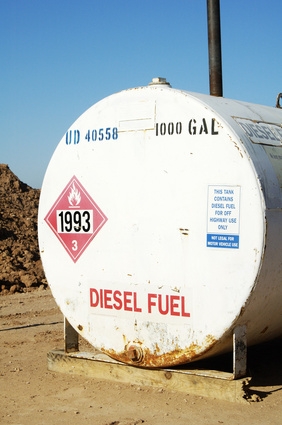
Diesel fuel powers motors from cars and pickup trucks to big rig trucks and heavy equipment. Like any petroleum-based product, it needs special handling for it to be a safe product to use. The U.S. Occupational Safety and Health Administration (OSHA) and Environmental Protection Agency (EPA) both have guidelines in place for diesel fuel safety measures and proper ways to store diesel fuel.
Diesel fuel comes in three grades. The diesel fuel tank must have proper signage as per the grade. The three grades vary on their pour point and viscosity, or thickness: 1D is best in cold conditions and 2D provides better miles per gallon in warmer weather while 4D diesel fuel is used to power large items of stationary equipment. Truckers especially don't want to put 2D diesel fuel in their semis in extremely cold temperatures or their fuel line may gel up, preventing the truck from running.
In addition to the diesel fuel tank having proper identification labels on it for the grades of diesel fuel, a material safety data sheet should be kept on the premises, which includes emergency contact numbers and identificaiton of health hazards from coming in contact with the diesel fuel and physical hazards present. Flammability warnings should also be present.
If someone breathes excessive amounts of diesel fuel fumes, it's important to move them away from the fuel. Headache and dizziness are two symptoms to watch for. Diesel fuel in the eyes needs flushing with clean water. Swallowing diesel fuel can cause severe damage to the lungs. Do not induce vomiting or give anything by mouth. Prompt medical attention is necessary.
Portable containers, designed specifically for diesel fuel, should have clear labeling on them. Storage in a clean, dry, well-ventilated garage or outbuilding is acceptable. Avoid setting the containers in direct sunlight.
Routine maintenance is necessary on diesel fuel storage tanks. If diesel fuel sits for more than a year, it starts to get a gummy residue that can have adverse effects on motors. It is important to rotate as much of the old diesel fuel out of the tank before adding new. Efforts to keep sediment from accumulating in the tank's bottom keep the fuel that comes from the tank clean. Routine removal of water vapor from condensation is also necessary to keep the fuel pure. Above-ground tanks must have a collection dam around the tank in case of spills.